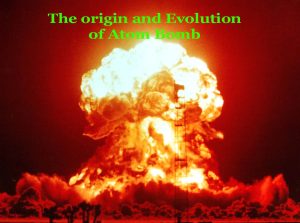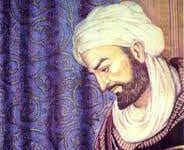Explore the origin and evolution of the atomic bomb, from its development during World War II to its impact on international relations and global security.” More discover key facts about the origin and evolution of the atomic bomb, including its early development, first uses in warfare, and the impact on global politics and arms control efforts.”
The Origin and Evolution of Atom Bomb
The atom bomb, also known as the atom bomb, is a weapon that derives its destructive power from nuclear reactions, specifically the fission of atomic nuclei. The creation and use of the atomic bomb was one of the most significant scientific and technological achievements of the 20th century, and its impact has reverberated throughout history. In this essay, we will discuss the origin and evolution of the atomic bomb, including its development, testing, and use, as well as its impact on society and the world.
Origins of the Atomic Bomb:
The idea of creating an atom bomb was first conceived during the early years of the 20th century when scientists began to study the properties of the atom. In 1898, Marie and Pierre Curie discovered the element radium, which led to further research into the structure of atoms. In 1905, Albert Einstein published his famous equation, E=mc2, which demonstrated the relationship between mass and energy, and paved the way for the development of nuclear weapons.
The modern atom bomb was developed during World War II, as part of the Manhattan Project. This project was a top-secret government initiative that was launched in 1942, with the goal of creating a nuclear weapon before Nazi Germany could do so. The Manhattan Project was led by physicist J. Robert Oppenheimer and involved a team of scientists and engineers from around the world.
Evolution of the Atom Bomb:
The evolution of the atom bomb can be divided into several phases. The first phase involved the development of the atomic bomb, which was accomplished through a series of scientific breakthroughs and engineering challenges. The scientists and engineers working on the Manhattan Project had to develop a way to split atomic nuclei in a controlled manner, and then find a way to harness the resulting energy.
The second phase of the evolution of the atomic bomb involved testing the weapon. The first test of an atomic bomb was conducted on July 16, 1945, at Alamogordo, New Mexico. The test, code-named Trinity, was a success, and it demonstrated the power of the atomic bomb.
The third phase of the evolution of the atom bomb involved its use in warfare. On August 6, 1945, the United States dropped an atomic bomb on the Japanese city of Hiroshima. The bomb, code-named Little Boy, had an explosive yield of about 15 kilotons of TNT and killed an estimated 140,000 people. Three days later, the United States dropped a second atomic bomb, code-named Fat Man, on the city of Nagasaki, killing an estimated 70,000 people.
Impact of the Atom Bomb:
The impact of the atom bomb was profound and far-reaching. In the short term, the use of the atomic bomb brought an end to World War II, as Japan surrendered on August 15, 1945. However, the use of the atomic bomb also had long-term consequences, both for the world and for the United States.
The use of the atom bomb raised ethical and moral questions about the use of nuclear weapons in warfare. The atomic bomb also sparked a nuclear arms race between the United States and the Soviet Union, which led to the development of even more powerful nuclear weapons and increased tensions between the two superpowers.
The atom bomb also had a significant impact on the scientific community. It demonstrated the power of nuclear energy and spurred research into peaceful uses of nuclear technology, such as nuclear power plants. 0 0 0.
The Origin and Evolution of Atom Bomb: FAQs
Here’s a set of FAQs on the origin and evolution of the atom bomb:
1. What is an atomic bomb?
An atom bomb is a weapon that derives its destructive power from nuclear reactions, either fission (splitting of atomic nuclei) or a combination of fission and fusion (combining atomic nuclei). This release of energy results in a massive explosion, accompanied by intense heat, radiation, and shockwaves.
2. When and why was the atom bomb developed?
The atom bomb was developed during World War II as part of the Manhattan Project, a secret U.S. research project initiated in 1942. The primary reason for its development was to ensure that the Allies, particularly the United States, could create a powerful weapon before Nazi Germany, which was also pursuing nuclear technology.
3. Who were the key scientists involved in the development of the atom bomb?
The development of the atom bomb involved numerous scientists, with key figures including J. Robert Oppenheimer (scientific director), Enrico Fermi, Richard Feynman, Niels Bohr, and many others. These scientists collaborated under the leadership of General Leslie Groves of the U.S. Army Corps of Engineers.
4. What were the first atom bombs used in warfare?
The first atom bombs used in warfare were dropped by the United States on the Japanese cities of Hiroshima and Nagasaki on August 6 and August 9, 1945, respectively. The bomb dropped on Hiroshima was named “Little Boy,” and the one dropped on Nagasaki was called “Fat Man.” These bombings led to Japan’s surrender and the end of World War II.
5. What were the immediate effects of the Hiroshima and Nagasaki bombings?
The immediate effects included massive destruction of the cities, killing an estimated 140,000 people in Hiroshima and 70,000 in Nagasaki by the end of 1945 due to the blast, heat, and radiation. Many more suffer from long-term health effects, including radiation sickness, cancer, and genetic damage.
6. How did the development of the atom bomb influence the Cold War?
The development of the atomic bomb significantly influenced the Cold War, as it led to an arms race between the United States and the Soviet Union. Both superpowers sought to build larger and more powerful nuclear arsenals, including hydrogen bombs, leading to a tense period of nuclear brinkmanship.
7. What is the difference between an atom bomb and a hydrogen bomb?
An atomic bomb relies on nuclear fission to release energy, while a hydrogen bomb (or thermonuclear bomb) uses fusion, where hydrogen isotopes combine under extremely high temperatures to release a far greater amount of energy. Hydrogen bombs are significantly more powerful than atomic bombs.
8. What are the long-term environmental impacts of atom bombs?
The long-term environmental impacts include radiation contamination, which can affect ecosystems and human health for decades. The fallout from atomic bomb testing has led to increased levels of radiation in certain areas, contributing to health issues such as cancer, birth defects, and genetic mutations.
9. How has the development of atom bombs affected international relations?
The existence of atom bombs has led to the establishment of international treaties and agreements aimed at controlling the proliferation of nuclear weapons, such as the Treaty on the Non-Proliferation of Nuclear Weapons (NPT). However, the threat of nuclear warfare continues to influence global politics, with ongoing debates about disarmament and nuclear security.
10. What measures are in place to prevent the use of atomic bombs today?
Measures include international treaties like the NPT, the Comprehensive Nuclear-Test-Ban Treaty (CTBT), and various arms reduction agreements between nuclear-armed states. There are also diplomatic efforts, non-proliferation policies, and monitoring by international organizations such as the International Atomic Energy Agency (IAEA) to prevent the spread and use of nuclear weapons. 0 0 0
The Origin and Evolution of Atom Bomb: Facts
Here’s a set of key facts about the origin and evolution of the atom bomb:
- Early Theories and Discoveries: The foundation of the atomic bomb lies in the discovery of nuclear fission by German physicists Otto Hahn and Fritz Strassmann in 1938, and the theoretical explanation by Lise Meitner and Otto Frisch. Fission is the process in which the nucleus of an atom splits into smaller parts, releasing a tremendous amount of energy.
- The Manhattan Project: The Manhattan Project was a secret U.S. government research project that began in 1942, tasked with developing an atomic bomb during World War II. It involved collaboration among the United States, the United Kingdom, and Canada, and included research facilities across the U.S., most notably in Los Alamos, New Mexico.
- Key Scientists: Key figures included J. Robert Oppenheimer, often called the “father of the atomic bomb,” Enrico Fermi, who created the first nuclear reactor, and Niels Bohr, who provided crucial theoretical insights. Over 130,000 people were involved in the Manhattan Project, including physicists, engineers, and military personnel.
- First Successful Test: The first successful test of an atomic bomb, codenamed “Trinity,” took place on July 16, 1945, in the New Mexico desert. The explosion produced a blast equivalent to about 20 kilotons of TNT.
- Use in World War II: The atomic bomb was first used in warfare by the United States against Japan. On August 6, 1945, the bomb “Little Boy” was dropped on Hiroshima, and on August 9, 1945, “Fat Man” was dropped on Nagasaki. The bombings led to Japan’s unconditional surrender on August 15, 1945, effectively ending World War II.
- Impact on Hiroshima and Nagasaki: The bomb dropped on Hiroshima killed an estimated 140,000 people by the end of 1945, while the Nagasaki bomb killed about 70,000. The intense heat, blast, and radiation caused immediate destruction, long-term health issues, and environmental damage.
- Evolution into the Cold War Era: After World War II, the atomic bomb became a central element of the Cold War arms race between the United States and the Soviet Union. In 1949, the Soviet Union tested its first atomic bomb, ending the U.S. monopoly on nuclear weapons and escalating the nuclear arms race.
- Development of the Hydrogen Bomb: In the 1950s, the hydrogen bomb, or thermonuclear bomb, was developed. It uses nuclear fusion in addition to fission, resulting in a bomb that is far more powerful than the original atomic bombs. The first hydrogen bomb, tested by the U.S. in 1952, was over 500 times more powerful than the bombs dropped on Japan.
- Nuclear Proliferation and Arms Control: The spread of nuclear weapons technology led to concerns about global security, resulting in efforts to control and reduce nuclear arsenals. Key treaties include the Treaty on the Non-Proliferation of Nuclear Weapons (NPT) in 1968 and various bilateral agreements like the Strategic Arms Reduction Treaty (START) between the U.S. and Russia.
- Modern Day and Legacy: Today, nine countries possess nuclear weapons, with thousands of warheads combined. While no atomic bomb has been used in conflict since 1945, the threat of nuclear warfare persists. The legacy of the atomic bomb includes ongoing debates over nuclear ethics, disarmament, and the balance of power in international relations.
These facts provide an overview of the atom bomb’s origin, development, and continuing impact on global history and politics.
Sources:
Rhodes, Richard. The Making of the Atomic Bomb. Simon & Schuster, 1986.
Hewlett, Richard G. and Oscar E. Anderson Jr. The New World, 1939-1946. University Press of Virginia, 1973.
Norris, Robert S. Racing for the Bomb:
You May Like:
- The Steady State Theory of the Origin of the Universe
- The History of Jupiter Exploration
- The Exploration of the Sun
N.B. The article ‘The Origin and Evolution of Atom Bomb’ originally belongs to the book ‘Essays on Science And Technology‘ by Menonim Menonimus.
Books of Composition by M. Menonimus:
- Advertisement Writing
- Amplification Writing
- Note Making
- Paragraph Writing
- Notice Writing
- Passage Comprehension
- The Art of Poster Writing
- The Art of Letter Writing
- Report Writing
- Story Writing
- Substance Writing
- School Essays Part-I
- School Essays Part-II
- School English Grammar Part-I
- School English Grammar Part-II..
Related Search:
- Atomic Bomb
- The Story of the Atomic Bomb
- Evolution of Digital Technology
- Digital Technology











